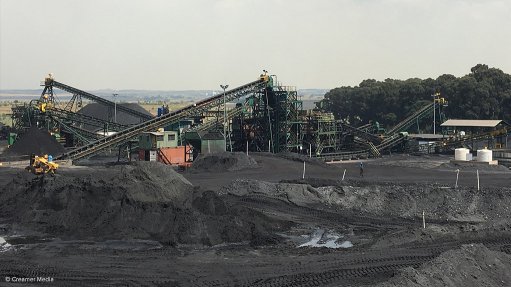
ELANDSPRUIT PROCESSING PLANT The run of mine feed capacity of the Elandspruit processing plant has been increased to 200 000 t/m, with the approximate remaining tonnage either sold as raw product, or blended
Photo by: Nadine James
JOHANNESBURG (miningweekly.com) - JSE-listed Wescoal is seeking to extract organic growth by optimising its existing operations and diversifying its revenue base, says Wescoal CFO Izak van der Walt.
During a media site visit to the miner’s Elandspruit operation, on Tuesday, he noted that the acquisition of Keaton Energy, in 2017, had provided several benefits, including the transfer of the Vanggatfontein and Moabsvelden assets.
The complete integration and optimisation of these assets is a priority for Wescoal in the short term.
Van der Walt further noted that Wescoal had achieved sustained growth in the last five years and that its Wescoal Trading division sold about one-million tonnes a year of product, resulting in yearly turnover of about R1-billion.
He added that 64% of Wescoal’s revenue was now generated from mining activity, an 14% increase that could be attributed to the Keaton acquisition.
Further, 41% of the company’s coal is now sold to State-owned power utility Eskom, as Vanggatfontein produces coal solely for Eskom’s use.
Van der Walt added that the coal miner is considering ways to diversify its revenue base, “in terms of logistical and distribution channels, and increasing exports.”
Wescoal Mining CEO Thivha Tshithavhane noted that about 10% of Wescoal’s production is exported.
Wescoal expects its run-of-mine (RoM) production for the full 2018 financial year to reach eight-million tonnes.
Wescoal’s Intibane mine, which started producing in 2016, produces about 95 000 t/m, so too does Khanyisa, which was brought out of care and maintenance last year.
Elandspruit produces about 260 000 t/m, with 220 000 t/m produced at the opencast operation and between 20 000 t/m and 30 000 t/m by the underground operation.
Tshithavhane explained that the underground operation’s activities are synchronised with that of the opencast operation in order to maximise production. He said Wescoal is leveraging its synergies with neighbours to facilitate the development of additional opencast mining faces. Elandspruit has already gained one additional face.
In light of the increased production, the RoM feed capacity of the Elandspruit processing plant has been increased to 200 000 t/m, with the approximate remaining tonnage either sold as raw product, or blended.
Tshithavhane added that Wescoal has entered into a toll-washing agreement with another neighbouring mine, enabling the miner to increase its processing capacity without expending capital.
Further, the miner had invested R37-million in projects to improve and expand operations, including the upgrade of the Wescoal processing plant, completing the diversion of the D20 road at Elandspruit and development to enable access to resources in the Catwalk area of the Khanyisa mine.
He noted that about R80-million has been put aside, primarily to line the pollution control dams in line with the new regulations in the National Environmental Management Act, as well as to install collision avoidance systems on the trackless mobile machinery, in line with requirement in the Mine Health and Safety Act.
Meanwhile, with regard to the development of the Moabsvelden project, Tshithavhane noted that the analysis and planning phase is progressing as a short-term objective and that Wescoal is currently using the prefeasibility study to determine the types of product that could be produced. The miner is also in discussions with potential offtakers.